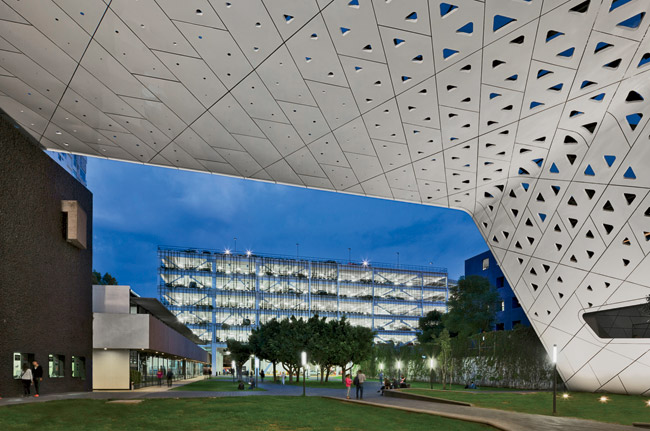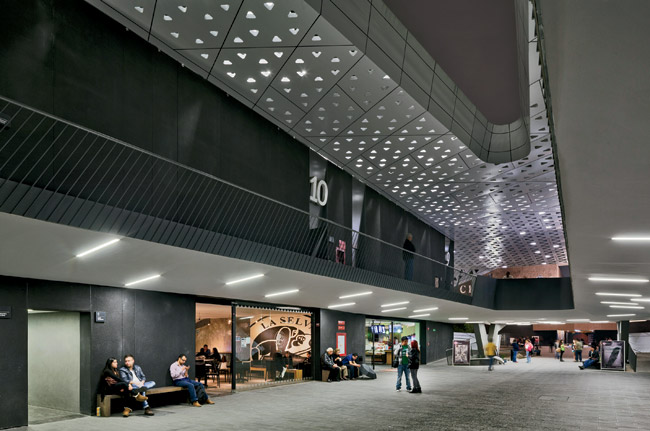Mexico City
The joke goes like this: the person handing out woven mats for visitors to sit on while watching outdoor film screenings on the lawn of Mexico City's Cineteca Nacional is said to ask young couples if they would like one mat, or—lilting into a suggestive tone—two. The first is to place over the sometimes damp grass as everyone does, but the second is to use as a blanket for concealing more serious make-out sessions. It may be a winking exaggeration of the teenage hijinks that go on at the Cineteca, but the joke is revealing. With an expansion of the institution, Rojkind Arquitectos has turned a repository for Mexico's cinematic history into a public space that welcomes the sometimes unruly life of this teeming city.
The architects had their work cut out for them. Prior to the expansion, the site committed all the sins of 20th-century, car-centric planning. Designed by Manuel Rocha, the four charmingly dated theater buildings were completed in 1982 with sandpaper-like facades of rugged brown concrete. On one side of them, a cluster of rectangular buildings house vaults for the archive, while a long box on the other accommodated administrative offices. But the rest of the site was entirely taken up by acres of surface parking.
To turn the expanse into a more hospitable background for the new theaters and other amenities, Rojkind Arquitectos set out to soften the landscape. The firm consolidated parking on the east side with a six-story garage wrapped in a plant trellis. A new two-level, 16,000-square-foot theater building, two rectangular volumes bridged by a mezzanine, sits across from the existing screening rooms. After making those additions, the firm converted much of the remaining space into stylized lawns.
The architect tied together the new and old buildings as well as the green spaces with a big gesture. A gleaming, slightly Star Wars'looking white facade wraps around the new theaters and glides up as a continuous surface to become a 120-foot-long canopy. The span connects the new building to the existing theaters and creates a sheltered plaza below. The dramatic steel construction is clad in composite aluminum panels perforated with triangular openings that widen and narrow to control the amount of sunlight passing through the covering.
The canopy's bombastic shape gives the Cineteca a bold architectural identity and a new public profile—a symbol of the dynamic urban life it invites in. The sweeping form pulls you through the progression of spaces, but it also defines places to hang out, including the central plaza and the mezzanine, where the ice cream bar's wares come from the famed Roxy shop. “Before, you used to come here to see a film and then get out,” says Rojkind. “But now you can make a day of it.”
The appeal is borne out by attendance figures. The Cineteca sold 1.3 million tickets in the first year after its renovation, up from 650,000 in annual sales in the calendar year before the expansion. On a daytime visit last year, groups of non-ticket holders lingered in the parklike spaces on the way to a nearby metro station, even as construction continued on some forthcoming parts of the project. While Rojkind Arquitectos renovated the existing theaters, the client brought in Taller de Arquitectura (the firm run by Gabriela Carrillo and Mauricio Rocha, Manuel's son) to design a new film museum for the complex and to replace the administrative building with new offices and a library. Rocha has already finished renovating a black-box theater into a smartly detailed viewing room where visitors can screen digital transfers of films on private kiosks, but the pyramid-shaped museum is still several months from completion.
A few other components of the Cineteca are also works in progress. Officials put pressure on the construction team to open the national cinema before former president Felipe Calder'n left office in December 2012. As a result, the cinema debuted with hasty finishes and incomplete components. But Rojkind and his firm have pushed the new administration to upgrade some of the materials and see the project to completion, and they have made significant progress over the last year. Now, there are plans to add more bike racks and a beer garden, among other new amenities.
The process has been slow going, but Rojkind is content with his compromise. “We sacrificed better details to have a better campus,” he says. “The details can be improved, but this was our one shot to make a great public space.” Finished or not, it's already an excellent place to bring a date.
People
Formal name of building:
Location:
Completion Date:
Gross square footage:
Total construction cost:
Owner:
Architect's firm name, address, phone, and fax number:
Personnel in architect's firm who should receive special credit:
Interior designer:
Engineer(s):
Roof Engineer:
MEP:
Consultant(s):
Lighting:
Theater and AV Consultant:
Acustical:
Graphic design:
General contractor:
Photographer(s):
Renderer:
CAD system, project management, or other software used: Size: 530,000 square feet Cost: $30 million Completion date: Ongoing |
Products
Structural system
Exterior cladding
Roofing
Windows
Glazing
Doors
Hardware
Interior finishes
Furnishings
Lighting
Exterior:
Conveyance
Plumbing |



























